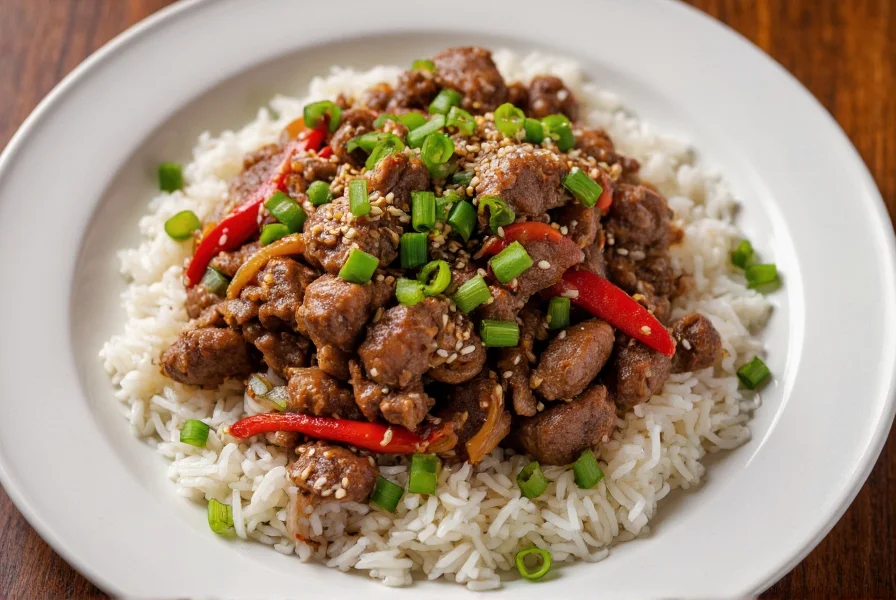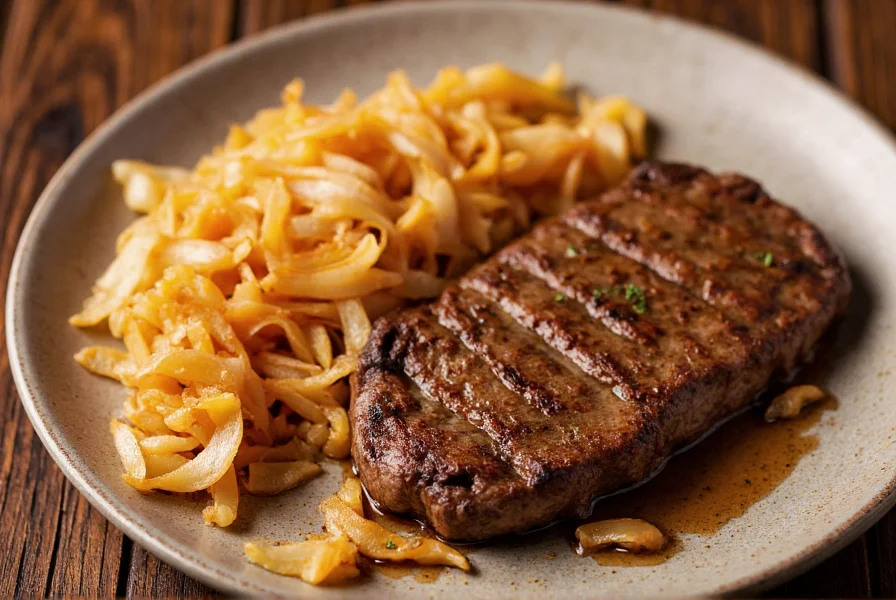If you've ever wondered why restaurant-style pepper steak with onions tastes so much better than your homemade attempts, the secret lies in proper technique and ingredient selection. This beloved American-Chinese classic combines tender beef strips with crisp bell peppers and sweet onions in a rich, savory sauce that clings perfectly to every bite. While simple in concept, mastering pepper steak with onions requires understanding key elements that transform this humble dish from ordinary to extraordinary.
Why This Pepper Steak Recipe Works
The magic of authentic pepper steak with onions happens through three critical components: proper meat selection, precise slicing technique, and the right cooking method. Unlike many online recipes that use questionable cuts or cooking approaches, this version delivers restaurant-quality results in your home kitchen.
Choosing the Perfect Cut for Pepper Steak with Onions
Not all steak cuts perform equally in this dish. The best options balance tenderness with flavor:
| Cut | Why It Works | Preparation Tip |
|---|---|---|
| Flank Steak | Rich beef flavor, affordable, widely available | Slice paper-thin against the grain |
| Sirloin | Natural tenderness, good marbling | Partially freeze before slicing |
| Skirt Steak | Intense flavor, excellent for stir-fries | Cut across the grain at 45-degree angle |
Avoid tenderloin or filet mignon—they're too delicate for high-heat stir-frying and lack the robust flavor this dish requires. For authentic pepper steak with onions, flank steak remains the top choice for its perfect balance of flavor, texture, and value.
Essential Ingredients for Classic Pepper Steak
The traditional pepper steak with onions recipe uses simple ingredients that create complex flavors when properly combined:
- Beef: 1½ pounds flank steak, sliced against the grain
- Vegetables: 2 bell peppers (mixed colors), 1 large yellow onion, sliced
- Sauce: Soy sauce, oyster sauce, rice vinegar, brown sugar, cornstarch
- Aromatics: Fresh ginger, garlic
- Cooking oil: High smoke point oil like peanut or avocado
The ratio matters—use approximately 2:1 peppers to onions for balanced flavor. Red and yellow bell peppers provide sweetness, while green peppers add that classic stir-fry bite. For the best homemade pepper steak with onions, never substitute frozen peppers as they release too much water during cooking.

Step-by-Step Pepper Steak with Onions Recipe
Follow these professional techniques to achieve restaurant-quality results:
Preparation (15 minutes)
- Partially freeze the flank steak for 45 minutes for easier slicing
- Cut steak across the grain into ¼-inch thick strips
- Combine marinade ingredients: 2 tbsp soy sauce, 1 tbsp rice wine, 1 tsp cornstarch, 1 tsp sesame oil
- Toss steak with marinade and let sit 10 minutes
- Prepare sauce: 3 tbsp soy sauce, 2 tbsp oyster sauce, 1 tbsp brown sugar, 1 tbsp rice vinegar, 2 tsp cornstarch, ¼ cup broth
- Slice peppers and onions into uniform 2-inch strips
Cooking (8-10 minutes)
- Heat wok or large skillet over highest heat until smoking
- Add 2 tbsp oil, swirl to coat surface
- Working in batches, sear steak 60-90 seconds per side until browned but not cooked through
- Remove steak, set aside
- Add 1 tbsp oil, stir-fry peppers and onions 2-3 minutes until crisp-tender
- Return steak to pan, pour sauce over ingredients
- Cook 60-90 seconds until sauce thickens and coats everything evenly
Pro Tips for Perfect Pepper Steak Every Time
Avoid these common mistakes that ruin homemade pepper steak with onions:
- Don't overcrowd the pan: Cook steak in batches to ensure proper searing
- High heat is non-negotiable: Medium heat steams the ingredients instead of stir-frying
- Slice against the grain: This cuts through muscle fibers for maximum tenderness
- Prep everything before cooking: Stir-frying happens too fast to measure ingredients mid-process
- Don't overcook the sauce: Remove from heat as soon as it thickens to prevent gumminess
Serving Suggestions for Pepper Steak with Onions
This versatile dish pairs perfectly with:
- Steamed jasmine rice (the classic accompaniment)
- Fried rice for a complete meal-in-one
- Chow mein noodles for extra crunch
- Simple cucumber salad to balance richness
Garnish with toasted sesame seeds or sliced green onions for presentation. For the most authentic pepper steak with onions experience, serve immediately while piping hot—the texture deteriorates quickly as it sits.

Variations to Try
Once you've mastered the classic pepper steak with onions recipe, experiment with these adaptations:
- Szechuan style: Add 1 tsp chili garlic sauce and ½ tsp Szechuan peppercorns
- Honey pepper steak: Replace brown sugar with 2 tbsp honey for sweeter profile
- Low-sodium version: Use reduced-sodium soy sauce and increase rice vinegar
- Vegetarian alternative: Substitute beef with extra-firm tofu or seitan
Storage and Reheating Instructions
While pepper steak with onions tastes best fresh, leftovers can be stored properly:
- Refrigerate in airtight container for up to 3 days
- Freeze for up to 2 months (sauce may separate slightly when thawed)
- Reheat in skillet over medium heat with 1-2 tsp water to restore moisture
- Avoid microwaving as it makes the beef tough and vegetables soggy
Frequently Asked Questions
What's the best cut of beef for pepper steak with onions?
Flank steak is the ideal cut for pepper steak with onions, followed closely by sirloin. Both offer excellent flavor and texture when sliced properly against the grain. Flank steak's natural marbling provides rich beef flavor while remaining affordable. For the most tender pepper steak, always slice the meat when partially frozen and cut perpendicular to the muscle fibers.
Why is my homemade pepper steak tough?
Tough pepper steak usually results from three common mistakes: using the wrong cut of meat, slicing with (instead of against) the grain, or overcooking the beef. Flank steak requires proper slicing technique—always cut across the grain into thin strips. Additionally, cooking over insufficient heat causes the meat to stew rather than sear. For tender pepper steak with onions, cook in small batches over extremely high heat for just 60-90 seconds per side.
Can I make pepper steak with onions without a wok?
Absolutely. While a wok provides ideal heat distribution for authentic pepper steak with onions, you can achieve excellent results with a large cast-iron skillet or heavy-bottomed stainless steel pan. The critical factor is using the highest heat your stove can produce and ensuring your pan is properly preheated until smoking before adding oil. Avoid non-stick pans as they cannot reach the necessary temperatures for proper stir-frying.
How do I prevent my pepper steak sauce from being too watery?
A watery sauce typically happens when the cornstarch mixture isn't properly incorporated or when too much liquid is added. For the perfect pepper steak with onions sauce consistency, ensure your cornstarch is fully dissolved in cold liquid before adding to hot ingredients. Cook the sauce for exactly 60-90 seconds after adding—any longer and the cornstarch breaks down. Also, avoid overcrowding the pan with vegetables, as excess moisture from peppers and onions will thin the sauce.











 浙公网安备
33010002000092号
浙公网安备
33010002000092号 浙B2-20120091-4
浙B2-20120091-4